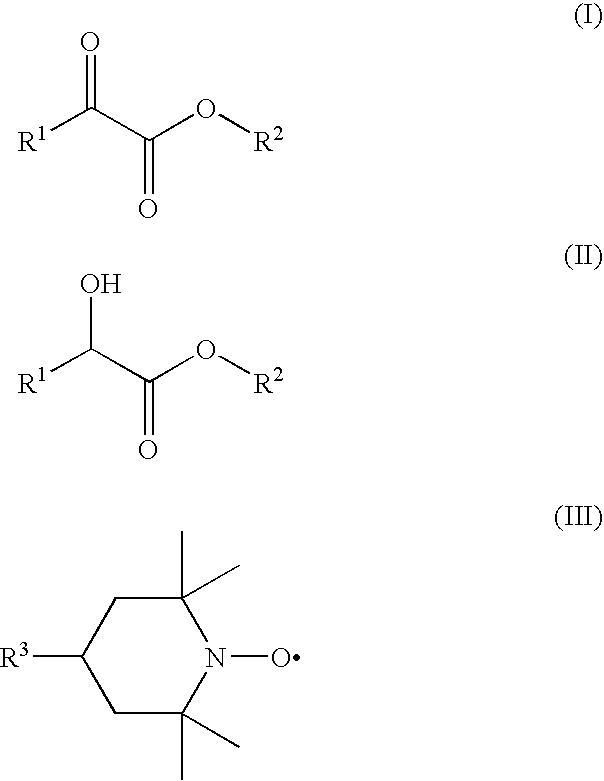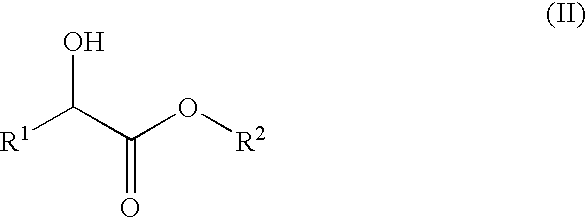Process for preparation of 2-oxocarboxylic acid esters
a technology of carboxylic acid and esters, which is applied in the preparation of carboxylic acid esters, chemistry apparatus and processes, and organic chemistry, etc., can solve the problems of difficult handling and none of these approaches is an industrially advantageous process
- Summary
- Abstract
- Description
- Claims
- Application Information
AI Technical Summary
Problems solved by technology
Method used
Image
Examples
example 1
[0022]10 g (84.7 mmol) of methyl 2-hydroxybutanoate, 0.09 g (0.42 mmol) of 4-acetoxy-2,2,6,6-tetramethylpiperidine-1-oxy, 0.87 g (8.47 mmol) of sodium bromide, 11 g of water and 43.4 g of ethyl acetate were placed in a 200 ml four-necked flask equipped with two dropping funnels, a thermometer, a pH meter and a stirrer. The temperature inside was lowered to 0 to 10° C. With the internal temperature kept below 10° C., 56.2 g (97.4 mmol) of 13% (by mass) aqueous solution of sodium hypochlorite was continuously added dropwise to the mixture. To prevent the pH of the reaction system from becoming basic during the addition of the aqueous solution of sodium hypochlorite, 20% (by mass) aqueous solution of phosphoric acid was also added dropwise to the mixture to maintain the pH of the reaction system within a range of 5 to 6. Following the addition of the aqueous solution of sodium hypochlorite, the reaction mixture was stirred for additional 1 hour. The organic and the aqueous layers were ...
example 2
[0024]10 g (84.7 mmol) of methyl 2-hydroxybutanoate, 0.09 g (0.42 mmol) of 4-acetoxy-2,2,6,6-tetramethylpiperidine-1-oxy, 0.87 g (8.47 mmol) of sodium bromide, 11 g of water and 43.4 g of ethyl acetate were placed in a 200 ml four-necked flask equipped with two dropping funnels, a thermometer, a pH meter and a stirrer. The temperature inside was lowered to 0 to 10° C. With the internal temperature kept below 10° C., 56.2 g (97.4 mmol) of 13% (by mass) aqueous solution of sodium hypochlorite was continuously added dropwise to the mixture. To prevent the pH of the reaction system from becoming basic during the addition of the aqueous solution of sodium hypochlorite, 20% (by mass) aqueous solution of phosphoric acid was also added dropwise to the mixture to maintain the pH of the reaction system within a range of 6 to 6.5. Following the addition of the aqueous solution of sodium hypochlorite, the reaction mixture was stirred for additional 1 hour. The organic and the aqueous layers wer...
example 3
[0025]10 g (84.7 mmol) of methyl 2-hydroxybutanoate, 0.09 g (0.42 mmol) of 4-acetoxy-2,2,6,6-tetramethylpiperidine-1-oxy, 0.87 g (8.47 mmol) of sodium bromide, 11 g of water and 43.4 g of ethyl acetate were placed in a 200 ml four-necked flask equipped with two dropping funnels, a thermometer, a pH meter and a stirrer. The temperature inside was lowered to 0 to 10° C. With the internal temperature kept below 10° C., 56.2 g (97.4 mmol) of 13% (by mass) aqueous solution of sodium hypochlorite was continuously added dropwise to the mixture. To prevent the pH of the reaction system from becoming basic during the addition of the aqueous solution of sodium hypochlorite, 20% (by mass) aqueous solution of phosphoric acid was also added dropwise to the mixture to maintain the pH of the reaction system within a range of 6.5 to 7. Following the addition of the aqueous solution of sodium hypochlorite, the reaction mixture was stirred for additional 1 hour. The organic and the aqueous layers wer...
PUM
| Property | Measurement | Unit |
|---|---|---|
| pH | aaaaa | aaaaa |
| temperature | aaaaa | aaaaa |
| temperature | aaaaa | aaaaa |
Abstract
Description
Claims
Application Information
 Login to View More
Login to View More - R&D
- Intellectual Property
- Life Sciences
- Materials
- Tech Scout
- Unparalleled Data Quality
- Higher Quality Content
- 60% Fewer Hallucinations
Browse by: Latest US Patents, China's latest patents, Technical Efficacy Thesaurus, Application Domain, Technology Topic, Popular Technical Reports.
© 2025 PatSnap. All rights reserved.Legal|Privacy policy|Modern Slavery Act Transparency Statement|Sitemap|About US| Contact US: help@patsnap.com



